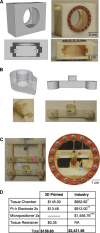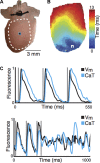Three-dimensional printing physiology laboratory technology
- PMID: 24043254
- PMCID: PMC3882465
- DOI: 10.1152/ajpheart.00599.2013
Three-dimensional printing physiology laboratory technology
Abstract
Since its inception in 19th-century Germany, the physiology laboratory has been a complex and expensive research enterprise involving experts in various fields of science and engineering. Physiology research has been critically dependent on cutting-edge technological support of mechanical, electrical, optical, and more recently computer engineers. Evolution of modern experimental equipment is constrained by lack of direct communication between the physiological community and industry producing this equipment. Fortunately, recent advances in open source technologies, including three-dimensional printing, open source hardware and software, present an exciting opportunity to bring the design and development of research instrumentation to the end user, i.e., life scientists. Here we provide an overview on how to develop customized, cost-effective experimental equipment for physiology laboratories.
Keywords: 3-D printing; heart physiology; open source manufacturing; optical mapping.
Figures





Similar articles
-
Design and validation of a tissue bath 3-D printed with PLA for optically mapping suspended whole heart preparations.Am J Physiol Heart Circ Physiol. 2017 Dec 1;313(6):H1190-H1198. doi: 10.1152/ajpheart.00150.2017. Epub 2017 Sep 22. Am J Physiol Heart Circ Physiol. 2017. PMID: 28939646 Free PMC article.
-
A preliminary investigation into the development of 3-D printing of prosthetic sockets.J Rehabil Res Dev. 2005 Mar-Apr;42(2):141-6. doi: 10.1682/jrrd.2004.08.0134. J Rehabil Res Dev. 2005. PMID: 15944878
-
Innovations in 3D printing: a 3D overview from optics to organs.Br J Ophthalmol. 2014 Feb;98(2):159-61. doi: 10.1136/bjophthalmol-2013-304446. Epub 2013 Nov 28. Br J Ophthalmol. 2014. PMID: 24288392 Review.
-
Open-source 3D-printable optics equipment.PLoS One. 2013;8(3):e59840. doi: 10.1371/journal.pone.0059840. Epub 2013 Mar 27. PLoS One. 2013. PMID: 23544104 Free PMC article.
-
Additive manufacturing: From implants to organs.S Afr Med J. 2014 May 12;104(6):408-9. doi: 10.7196/samj.7915. S Afr Med J. 2014. PMID: 25214247 Review.
Cited by
-
Applications of 3D printing in cardiovascular diseases.Nat Rev Cardiol. 2016 Dec;13(12):701-718. doi: 10.1038/nrcardio.2016.170. Epub 2016 Oct 27. Nat Rev Cardiol. 2016. PMID: 27786234 Review.
-
Bringing CLARITY to the human brain: visualization of Lewy pathology in three dimensions.Neuropathol Appl Neurobiol. 2016 Oct;42(6):573-87. doi: 10.1111/nan.12293. Epub 2015 Dec 7. Neuropathol Appl Neurobiol. 2016. PMID: 26526972 Free PMC article.
-
Open Design 3D-Printable Adjustable Micropipette that Meets the ISO Standard for Accuracy.Micromachines (Basel). 2018 Apr 18;9(4):191. doi: 10.3390/mi9040191. Micromachines (Basel). 2018. PMID: 30424124 Free PMC article.
-
Open Labware: 3-D printing your own lab equipment.PLoS Biol. 2015 Mar 20;13(3):e1002086. doi: 10.1371/journal.pbio.1002086. eCollection 2015 Mar. PLoS Biol. 2015. PMID: 25794301 Free PMC article.
-
PSoC-Stat: A single chip open source potentiostat based on a Programmable System on a Chip.PLoS One. 2018 Jul 25;13(7):e0201353. doi: 10.1371/journal.pone.0201353. eCollection 2018. PLoS One. 2018. PMID: 30044878 Free PMC article.
References
-
- Calvert P. Inkjet printing for materials and devices. Chem Mater 13: 3299–3305, 2001
-
- Chung K, Wallace J, Kim SY, Kalyanasundaram S, Andalman AS, Davidson TJ, Mirzabekov JJ, Zalocusky KA, Mattis J, Denisin AK, Pak S, Bernstein H, Ramakrishnan C, Grosenick L, Gradinaru V, Deisseroth K. Structural and molecular interrogation of intact biological systems. Nature 497: 332–337, 2013 - PMC - PubMed
-
- Fye WB. Carl Ludwig and the Leipzig Physiological Institute: ‘a factory of new knowledge’. Circulation 74: 920–8, 1986 - PubMed
-
- Jones R, Haufe P, Sells E, Iravani P, Olliver V, Palmer C, Bowyer A. RepRap—the replicating rapid prototyper. Robotica 29: 177–191, 2011
Publication types
MeSH terms
Grants and funding
LinkOut - more resources
Full Text Sources
Other Literature Sources

